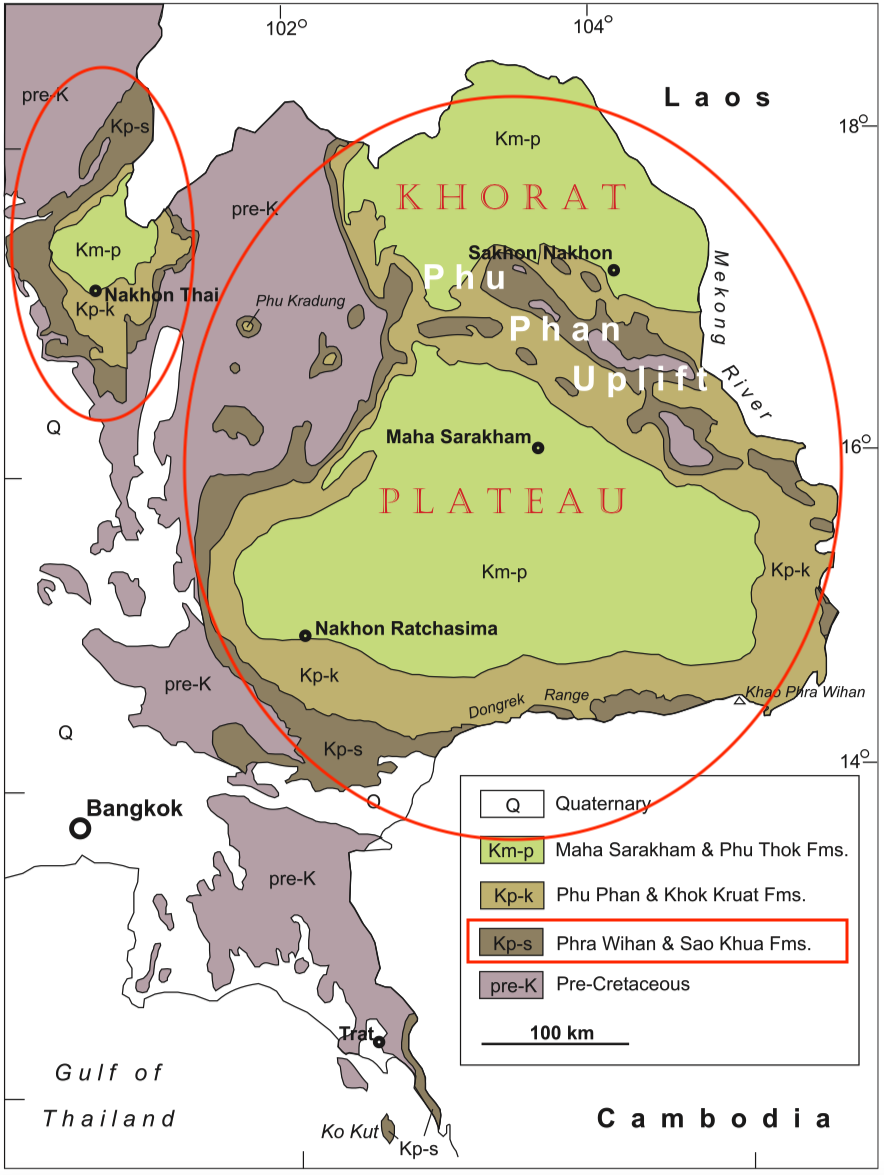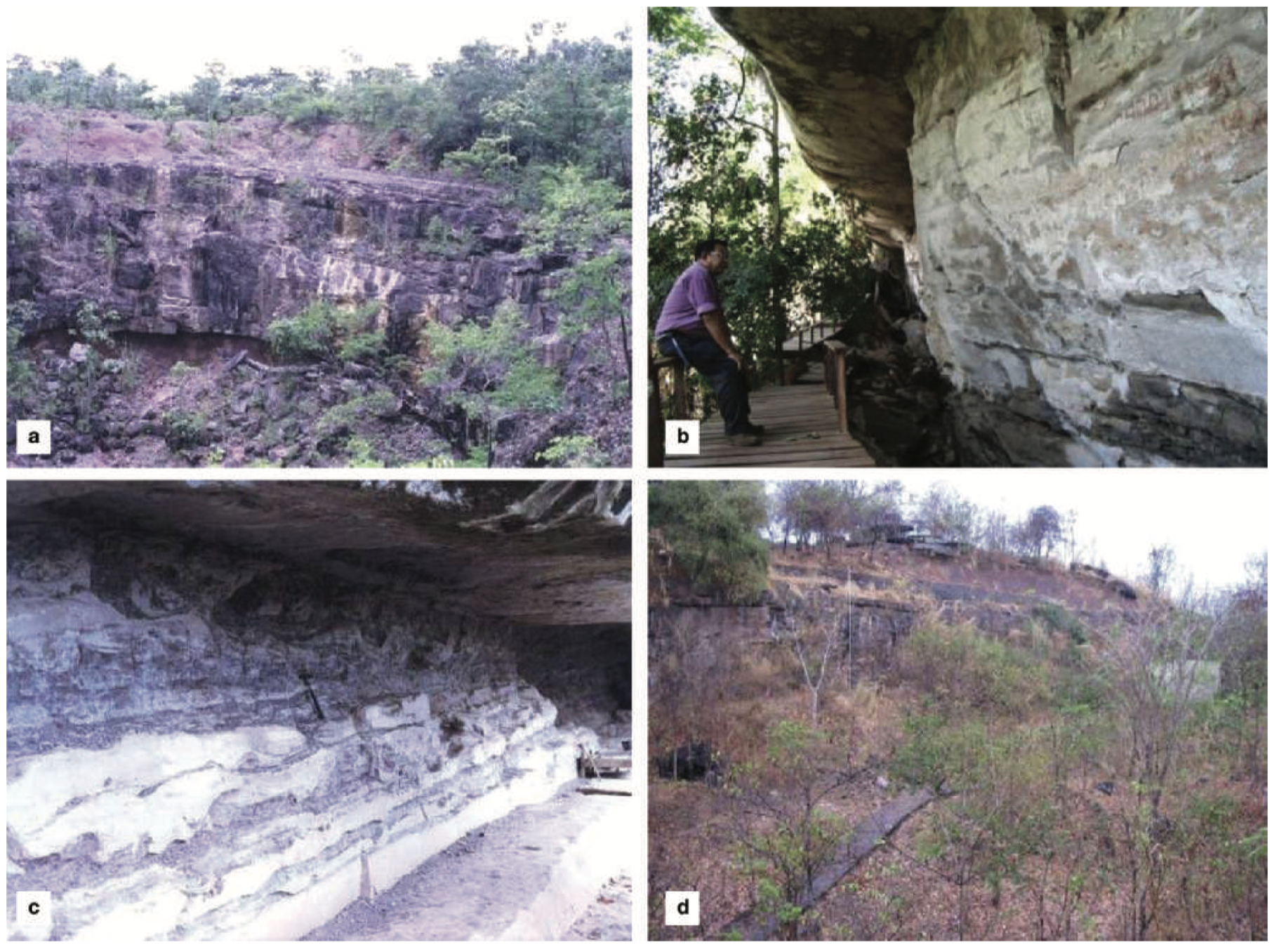Type Locality and Naming
At km post 35.2-41.5, Udon Thani-Nong Bua Lamphu Road; Imsamut (2003a) proposed reference sections at Khao Chamuk Khaek section, Lum Ngoen village of Nakhon Ratchasima province (821900E, 1614900N, 5338 II, L7018), at Phu Wiang Investigation Site 1 within Phu Wiang National Park, Khon Kaen province (204800E, 1846400N, 5442 III, L7018), at Phu khum Khao section of Sahat Sakhan district, Kalasin province (343300E, 1546000N, 5742 II, L7018). The best section of this formation is at Ban Kuan Bun along Highway 2239 in Tao Ngoi District, Sakhon Nakhon Province (Meesook, 2011). Parent unit:
Khorat Gr.
Synonym: หมวดหินเสาขัว
[Figure: NE and SE Thailand, showing distribution of Cretaceous outcrops. (Meesook, 2011. Page 170). At least some of the Pre-Cretaceous sedimentary rocks on the map may be Jurassic and the position of the Jurassic-Cretaceous boundary is discussed in Meesook (2011).]
GeoJSON
{"type":"Feature","geometry":{"type":"Polygon","coordinates":[[[100.86,17.97],[100.84,17.82],[100.73,17.64],[100.5,17.26],[100.28,16.84],[100.18,16.41],[100.28,15.88],[100.48,15.55],[100.45,15.3],[100.53,14.96],[100.66,14.73],[100.91,14.5],[101.11,14.45],[101.51,14.44],[102.13,14.69],[102.42,14.84],[102.67,14.92],[102.84,14.96],[103.08,14.98],[103.24,15.04],[103.43,15.12],[103.51,15.18],[103.65,15.34],[103.72,15.57],[103.73,16.03],[103.66,16.46],[103.45,16.87],[103.16,17.27],[102.66,17.53],[102.29,17.74],[101.89,17.99],[101.7,17.96],[101.63,17.81],[101.48,17.81],[101.34,17.66],[101.16,17.49],[100.98,17.53],[100.93,17.66],[100.99,17.81],[101.1,17.99],[100.86,17.97]]]}}
Fossils
Dinosaur fragments and turtle plates have been found at Tao Ngoi and Phu Phan Districts, Sakhon Nakhon Province and at Phu Khum Khao in Sahat Sakhan District, Kalasin Province. The
Sao Khua Formation has yielded the richest and most diverse vertebrate faunas found in Thailand, which have been the subject of a rapidly growing literature (Buffetaut & Suteethorn 1998). The crocodilian
Siamosuchus phuphokensis (Lauprasert et al. 2007) has been described as also have the theropod
Siamotyranus isanensis, which is considered to be the oldest and most primitive known tyrannosaurid (Buffetaut et al. 1996), and the sauropod
Phuwiangosaurus sirindhornae (Martin et al. 1994). Other vertebrate fossils include the first sinamiid fish from Southeast Asia (Cavin et al. 2007a, b), hybodont sharks (Cuny et al. 2005, 2006), turtles (Tong et al. 2006) and the first known fossil bird from the Mesozoic of Thailand (Buffetaut et al. 2005a). The Sirindhorn Museum exhibits many of the fossils found in the region and is located beside Highway 227 north of the city of Kalasin.
Invertebrate fossils, particularly bivalves, are also found in the Sao Khua Formation including Plicatounio, Unio, Koreanaia and Trigonioides (Meesook et al. 1995), Trigonioides (s.s.) trigonus, and ?Trigonioides cf. gaungsiensis (Sha Jingeng, pers. comm. 1997). Pieces of silicified wood in reddish-brown claystones are found in a few exposures. According to Hahn (1982), Racey et al. (1994, 1996) and Racey & Goodall (2009), abundant palynomorphs are present, suggesting a Berriasian–Barremian (Early Cretaceous) age for the formation (Meesook, 2011).

